Marks and Spencer Business Strategy: Diversification Implementation
VerifiedAdded on 2020/01/28
|6
|1143
|461
Report
AI Summary
This report analyzes Marks & Spencer's (M&S) diversification strategy, focusing on its expansion into the furniture market. It outlines a three-cycle implementation plan encompassing business planning, functional planning, and budgeting. The report details the roles and responsibilities of key personnel, including the Human Resource Manager, Finance Manager, and Operations Manager, highlighting their contributions to the diversification process. It further identifies the essential resource requirements, namely human resources and finance. The application of SMART goals within M&S is examined, demonstrating how the company utilizes specific, measurable, achievable, relevant, and time-bound objectives to achieve success. The report uses the SMART model to highlight the development of a new position in the furniture market, and the importance of skilled employees to interact with customers. The report concludes by referencing relevant academic literature that supports the strategies and concepts presented.
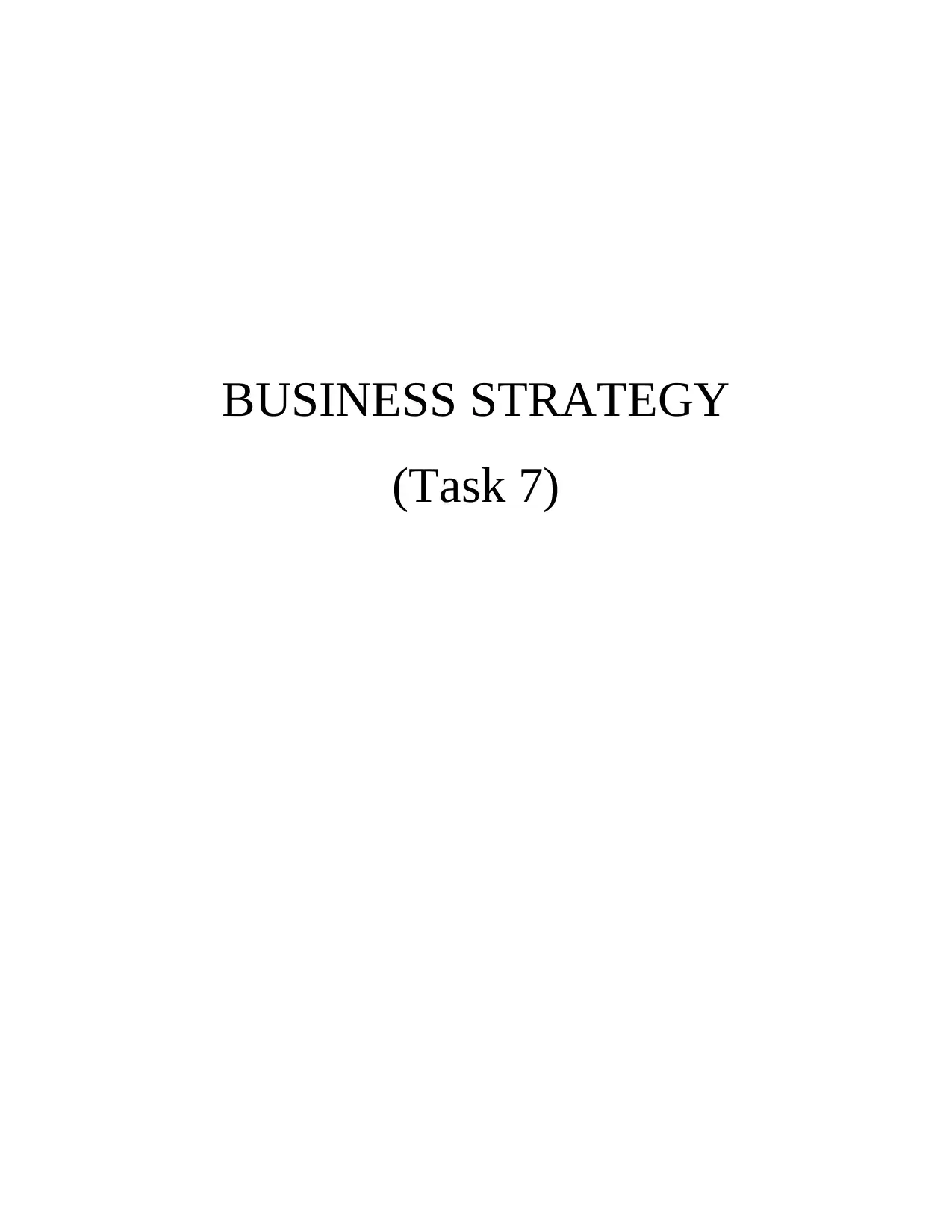
BUSINESS STRATEGY
(Task 7)
(Task 7)
Paraphrase This Document
Need a fresh take? Get an instant paraphrase of this document with our AI Paraphraser
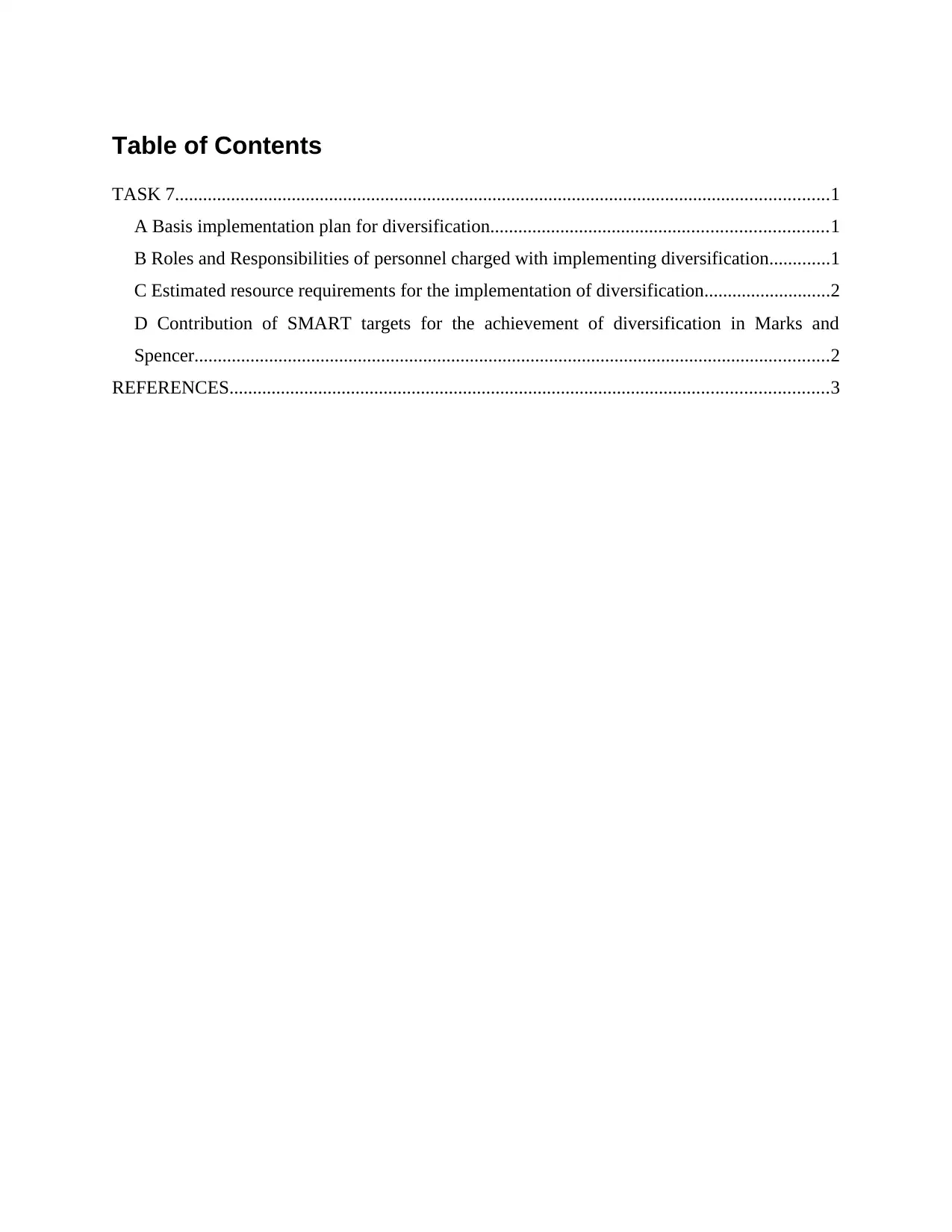
Table of Contents
TASK 7............................................................................................................................................1
A Basis implementation plan for diversification........................................................................1
B Roles and Responsibilities of personnel charged with implementing diversification.............1
C Estimated resource requirements for the implementation of diversification...........................2
D Contribution of SMART targets for the achievement of diversification in Marks and
Spencer........................................................................................................................................2
REFERENCES................................................................................................................................3
TASK 7............................................................................................................................................1
A Basis implementation plan for diversification........................................................................1
B Roles and Responsibilities of personnel charged with implementing diversification.............1
C Estimated resource requirements for the implementation of diversification...........................2
D Contribution of SMART targets for the achievement of diversification in Marks and
Spencer........................................................................................................................................2
REFERENCES................................................................................................................................3
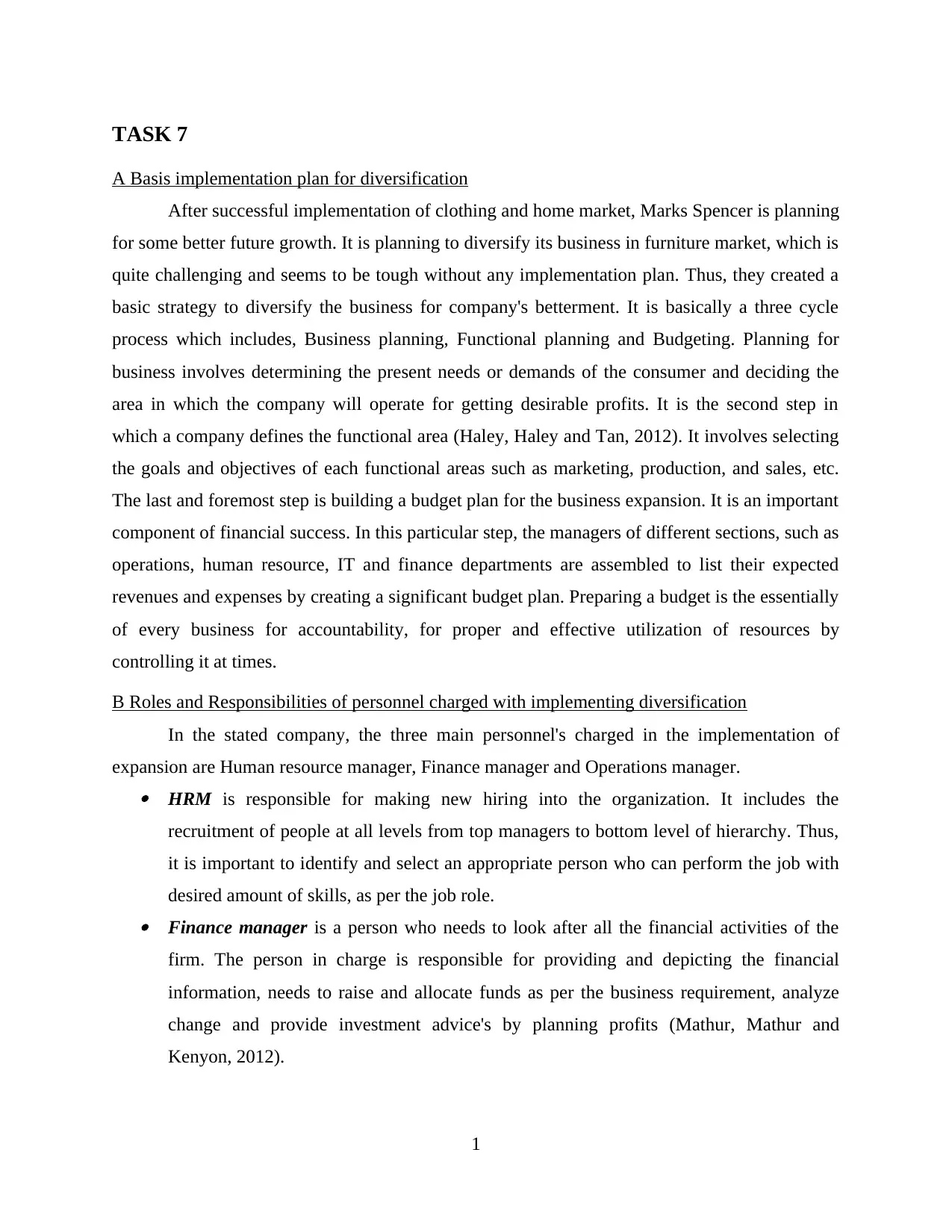
TASK 7
A Basis implementation plan for diversification
After successful implementation of clothing and home market, Marks Spencer is planning
for some better future growth. It is planning to diversify its business in furniture market, which is
quite challenging and seems to be tough without any implementation plan. Thus, they created a
basic strategy to diversify the business for company's betterment. It is basically a three cycle
process which includes, Business planning, Functional planning and Budgeting. Planning for
business involves determining the present needs or demands of the consumer and deciding the
area in which the company will operate for getting desirable profits. It is the second step in
which a company defines the functional area (Haley, Haley and Tan, 2012). It involves selecting
the goals and objectives of each functional areas such as marketing, production, and sales, etc.
The last and foremost step is building a budget plan for the business expansion. It is an important
component of financial success. In this particular step, the managers of different sections, such as
operations, human resource, IT and finance departments are assembled to list their expected
revenues and expenses by creating a significant budget plan. Preparing a budget is the essentially
of every business for accountability, for proper and effective utilization of resources by
controlling it at times.
B Roles and Responsibilities of personnel charged with implementing diversification
In the stated company, the three main personnel's charged in the implementation of
expansion are Human resource manager, Finance manager and Operations manager. HRM is responsible for making new hiring into the organization. It includes the
recruitment of people at all levels from top managers to bottom level of hierarchy. Thus,
it is important to identify and select an appropriate person who can perform the job with
desired amount of skills, as per the job role. Finance manager is a person who needs to look after all the financial activities of the
firm. The person in charge is responsible for providing and depicting the financial
information, needs to raise and allocate funds as per the business requirement, analyze
change and provide investment advice's by planning profits (Mathur, Mathur and
Kenyon, 2012).
1
A Basis implementation plan for diversification
After successful implementation of clothing and home market, Marks Spencer is planning
for some better future growth. It is planning to diversify its business in furniture market, which is
quite challenging and seems to be tough without any implementation plan. Thus, they created a
basic strategy to diversify the business for company's betterment. It is basically a three cycle
process which includes, Business planning, Functional planning and Budgeting. Planning for
business involves determining the present needs or demands of the consumer and deciding the
area in which the company will operate for getting desirable profits. It is the second step in
which a company defines the functional area (Haley, Haley and Tan, 2012). It involves selecting
the goals and objectives of each functional areas such as marketing, production, and sales, etc.
The last and foremost step is building a budget plan for the business expansion. It is an important
component of financial success. In this particular step, the managers of different sections, such as
operations, human resource, IT and finance departments are assembled to list their expected
revenues and expenses by creating a significant budget plan. Preparing a budget is the essentially
of every business for accountability, for proper and effective utilization of resources by
controlling it at times.
B Roles and Responsibilities of personnel charged with implementing diversification
In the stated company, the three main personnel's charged in the implementation of
expansion are Human resource manager, Finance manager and Operations manager. HRM is responsible for making new hiring into the organization. It includes the
recruitment of people at all levels from top managers to bottom level of hierarchy. Thus,
it is important to identify and select an appropriate person who can perform the job with
desired amount of skills, as per the job role. Finance manager is a person who needs to look after all the financial activities of the
firm. The person in charge is responsible for providing and depicting the financial
information, needs to raise and allocate funds as per the business requirement, analyze
change and provide investment advice's by planning profits (Mathur, Mathur and
Kenyon, 2012).
1
⊘ This is a preview!⊘
Do you want full access?
Subscribe today to unlock all pages.

Trusted by 1+ million students worldwide
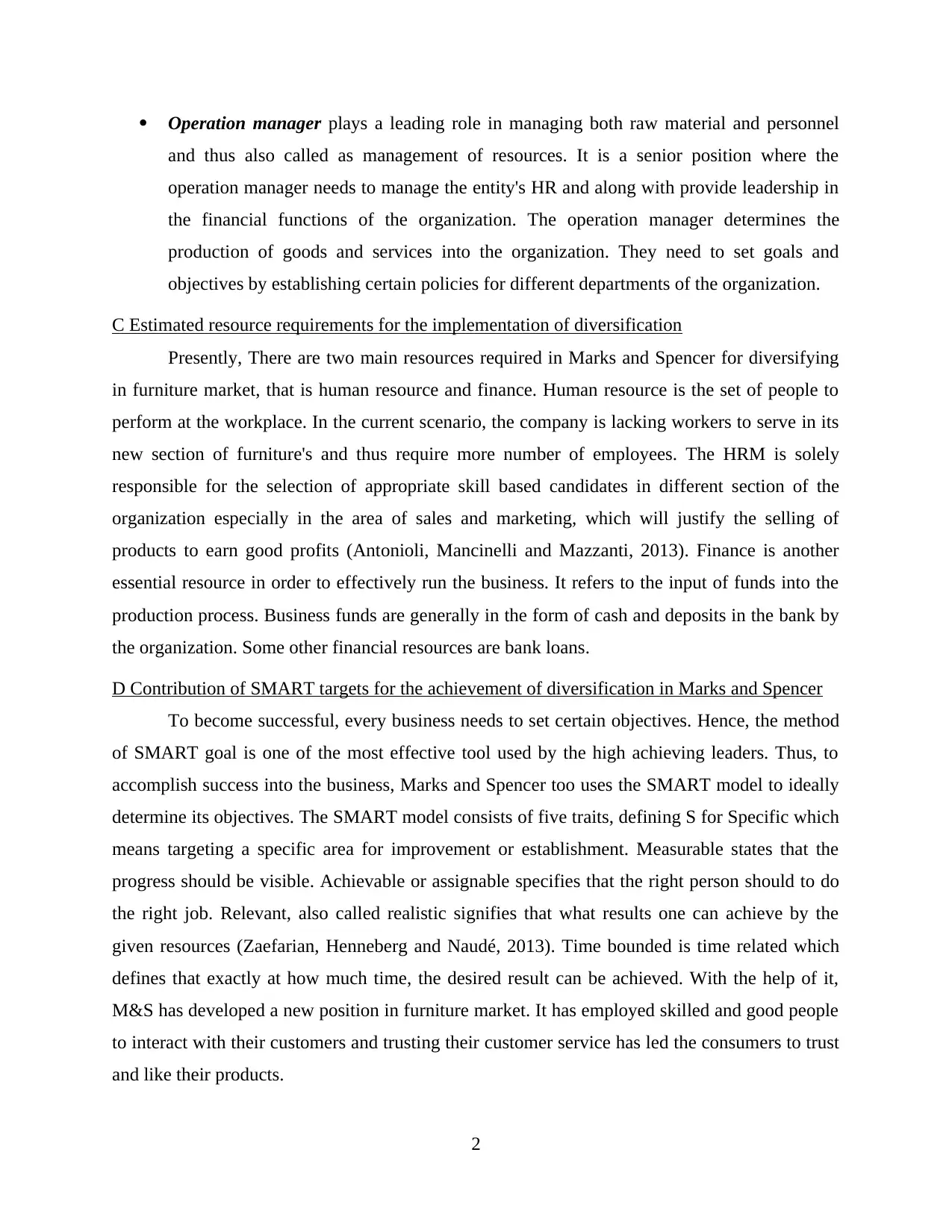
Operation manager plays a leading role in managing both raw material and personnel
and thus also called as management of resources. It is a senior position where the
operation manager needs to manage the entity's HR and along with provide leadership in
the financial functions of the organization. The operation manager determines the
production of goods and services into the organization. They need to set goals and
objectives by establishing certain policies for different departments of the organization.
C Estimated resource requirements for the implementation of diversification
Presently, There are two main resources required in Marks and Spencer for diversifying
in furniture market, that is human resource and finance. Human resource is the set of people to
perform at the workplace. In the current scenario, the company is lacking workers to serve in its
new section of furniture's and thus require more number of employees. The HRM is solely
responsible for the selection of appropriate skill based candidates in different section of the
organization especially in the area of sales and marketing, which will justify the selling of
products to earn good profits (Antonioli, Mancinelli and Mazzanti, 2013). Finance is another
essential resource in order to effectively run the business. It refers to the input of funds into the
production process. Business funds are generally in the form of cash and deposits in the bank by
the organization. Some other financial resources are bank loans.
D Contribution of SMART targets for the achievement of diversification in Marks and Spencer
To become successful, every business needs to set certain objectives. Hence, the method
of SMART goal is one of the most effective tool used by the high achieving leaders. Thus, to
accomplish success into the business, Marks and Spencer too uses the SMART model to ideally
determine its objectives. The SMART model consists of five traits, defining S for Specific which
means targeting a specific area for improvement or establishment. Measurable states that the
progress should be visible. Achievable or assignable specifies that the right person should to do
the right job. Relevant, also called realistic signifies that what results one can achieve by the
given resources (Zaefarian, Henneberg and Naudé, 2013). Time bounded is time related which
defines that exactly at how much time, the desired result can be achieved. With the help of it,
M&S has developed a new position in furniture market. It has employed skilled and good people
to interact with their customers and trusting their customer service has led the consumers to trust
and like their products.
2
and thus also called as management of resources. It is a senior position where the
operation manager needs to manage the entity's HR and along with provide leadership in
the financial functions of the organization. The operation manager determines the
production of goods and services into the organization. They need to set goals and
objectives by establishing certain policies for different departments of the organization.
C Estimated resource requirements for the implementation of diversification
Presently, There are two main resources required in Marks and Spencer for diversifying
in furniture market, that is human resource and finance. Human resource is the set of people to
perform at the workplace. In the current scenario, the company is lacking workers to serve in its
new section of furniture's and thus require more number of employees. The HRM is solely
responsible for the selection of appropriate skill based candidates in different section of the
organization especially in the area of sales and marketing, which will justify the selling of
products to earn good profits (Antonioli, Mancinelli and Mazzanti, 2013). Finance is another
essential resource in order to effectively run the business. It refers to the input of funds into the
production process. Business funds are generally in the form of cash and deposits in the bank by
the organization. Some other financial resources are bank loans.
D Contribution of SMART targets for the achievement of diversification in Marks and Spencer
To become successful, every business needs to set certain objectives. Hence, the method
of SMART goal is one of the most effective tool used by the high achieving leaders. Thus, to
accomplish success into the business, Marks and Spencer too uses the SMART model to ideally
determine its objectives. The SMART model consists of five traits, defining S for Specific which
means targeting a specific area for improvement or establishment. Measurable states that the
progress should be visible. Achievable or assignable specifies that the right person should to do
the right job. Relevant, also called realistic signifies that what results one can achieve by the
given resources (Zaefarian, Henneberg and Naudé, 2013). Time bounded is time related which
defines that exactly at how much time, the desired result can be achieved. With the help of it,
M&S has developed a new position in furniture market. It has employed skilled and good people
to interact with their customers and trusting their customer service has led the consumers to trust
and like their products.
2
Paraphrase This Document
Need a fresh take? Get an instant paraphrase of this document with our AI Paraphraser
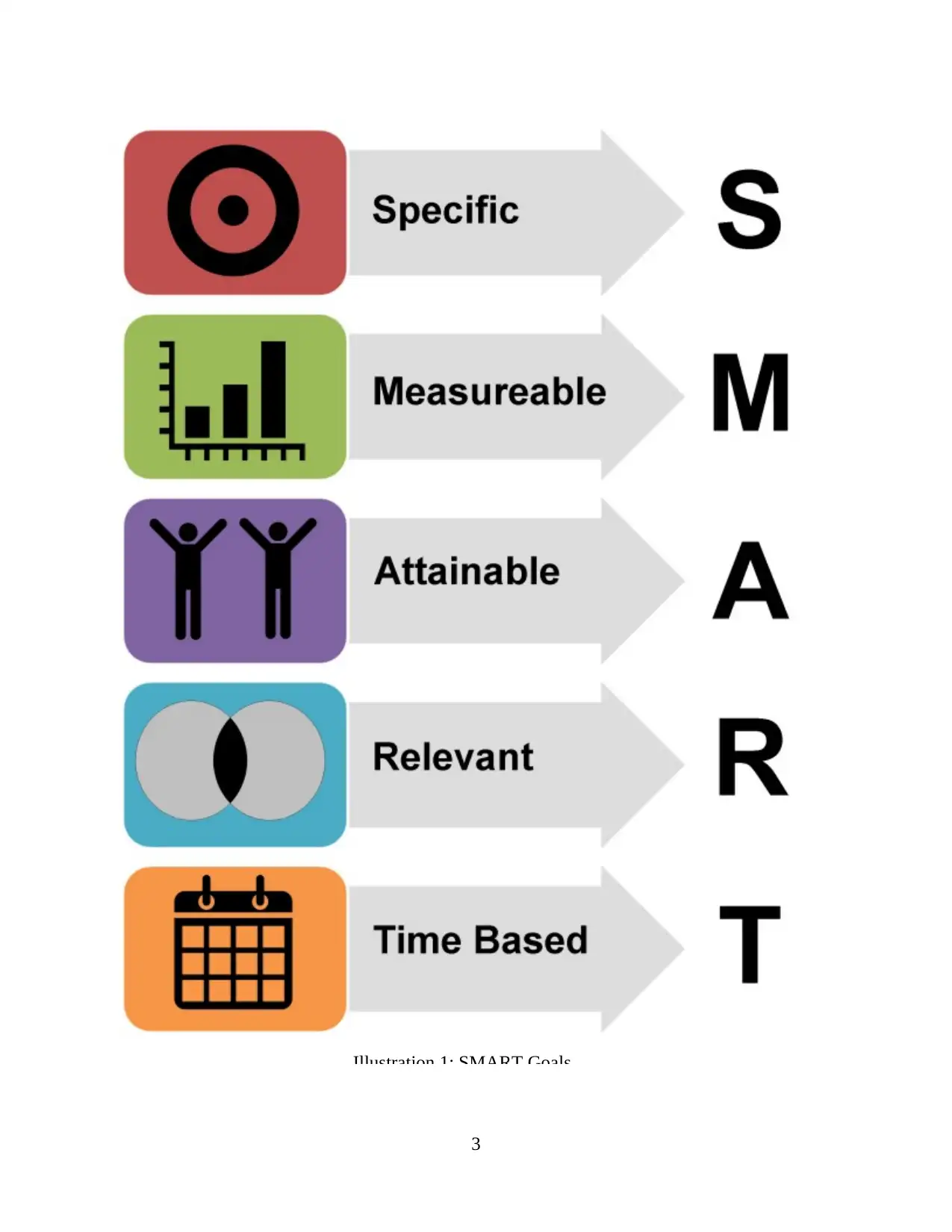
Illustration 1: SMART Goals
3
3
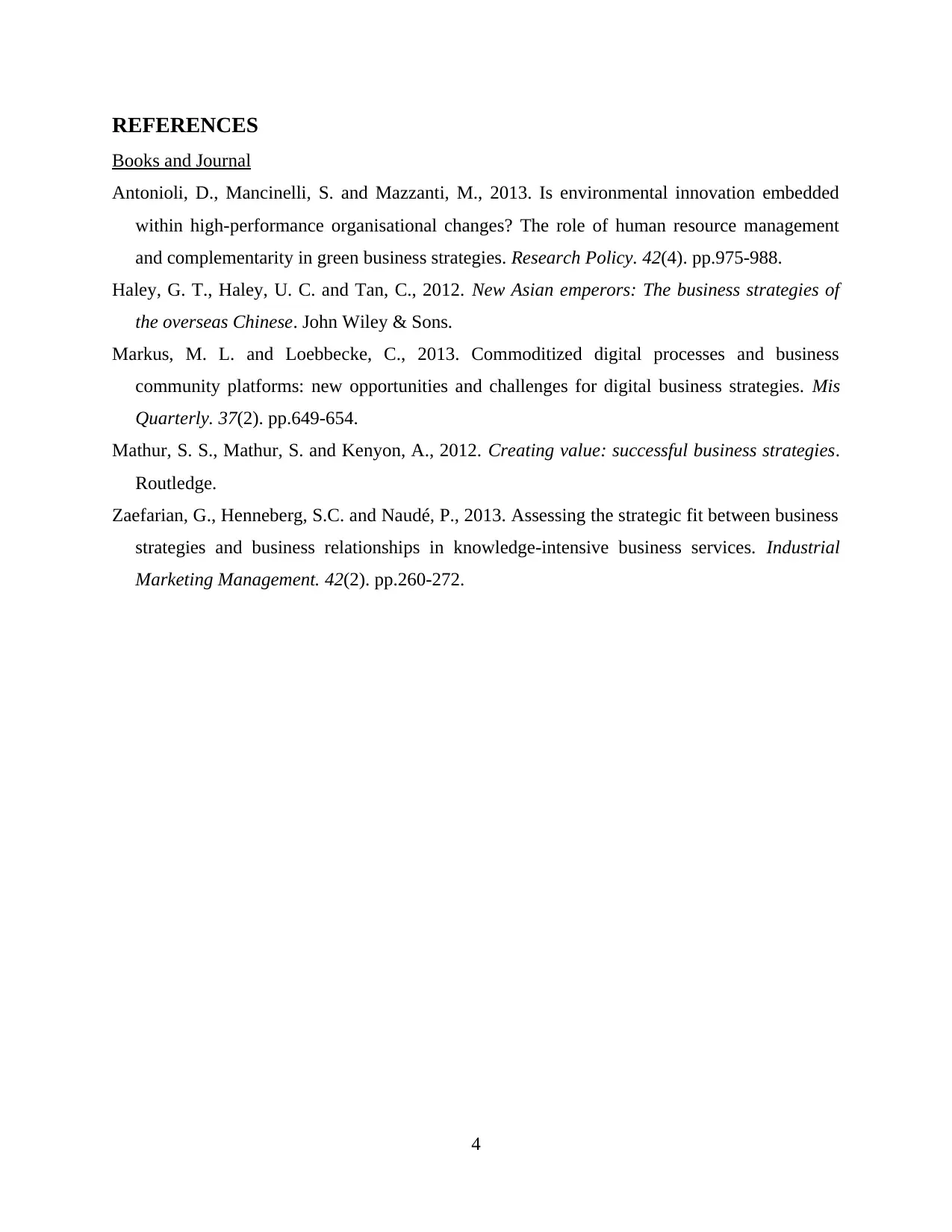
REFERENCES
Books and Journal
Antonioli, D., Mancinelli, S. and Mazzanti, M., 2013. Is environmental innovation embedded
within high-performance organisational changes? The role of human resource management
and complementarity in green business strategies. Research Policy. 42(4). pp.975-988.
Haley, G. T., Haley, U. C. and Tan, C., 2012. New Asian emperors: The business strategies of
the overseas Chinese. John Wiley & Sons.
Markus, M. L. and Loebbecke, C., 2013. Commoditized digital processes and business
community platforms: new opportunities and challenges for digital business strategies. Mis
Quarterly. 37(2). pp.649-654.
Mathur, S. S., Mathur, S. and Kenyon, A., 2012. Creating value: successful business strategies.
Routledge.
Zaefarian, G., Henneberg, S.C. and Naudé, P., 2013. Assessing the strategic fit between business
strategies and business relationships in knowledge-intensive business services. Industrial
Marketing Management. 42(2). pp.260-272.
4
Books and Journal
Antonioli, D., Mancinelli, S. and Mazzanti, M., 2013. Is environmental innovation embedded
within high-performance organisational changes? The role of human resource management
and complementarity in green business strategies. Research Policy. 42(4). pp.975-988.
Haley, G. T., Haley, U. C. and Tan, C., 2012. New Asian emperors: The business strategies of
the overseas Chinese. John Wiley & Sons.
Markus, M. L. and Loebbecke, C., 2013. Commoditized digital processes and business
community platforms: new opportunities and challenges for digital business strategies. Mis
Quarterly. 37(2). pp.649-654.
Mathur, S. S., Mathur, S. and Kenyon, A., 2012. Creating value: successful business strategies.
Routledge.
Zaefarian, G., Henneberg, S.C. and Naudé, P., 2013. Assessing the strategic fit between business
strategies and business relationships in knowledge-intensive business services. Industrial
Marketing Management. 42(2). pp.260-272.
4
⊘ This is a preview!⊘
Do you want full access?
Subscribe today to unlock all pages.

Trusted by 1+ million students worldwide
1 out of 6
Related Documents
Your All-in-One AI-Powered Toolkit for Academic Success.
+13062052269
info@desklib.com
Available 24*7 on WhatsApp / Email
![[object Object]](/_next/static/media/star-bottom.7253800d.svg)
Unlock your academic potential
Copyright © 2020–2025 A2Z Services. All Rights Reserved. Developed and managed by ZUCOL.




